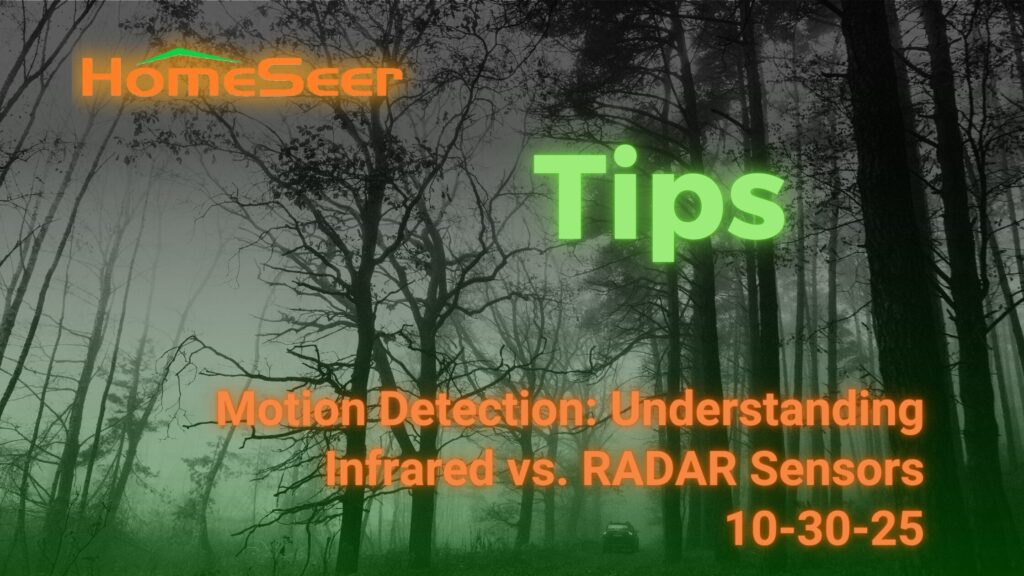By Jon-Luke West
In our increasingly automated world, motion sensors have become an integral part of our daily lives, from automatic doors at the grocery store to sophisticated home security systems. Two leading technologies dominate this space: infrared and RADAR sensors. While both serve the same basic purpose of detecting movement, their approaches and capabilities differ significantly. Let’s explore how each technology works and where they shine – or fall short
The Heat-Seeking Infrared Sensor
Infrared sensors, often called PIR (Passive Infrared) sensors, work like tiny heat cameras. They detect the infrared radiation naturally emitted by warm objects, particularly living beings. When a person walks through the sensor’s field of view, it detects the moving heat signature against the cooler background. The most important thing to remember about this is that they are looking for differences in temperature.
Where Infrared Excels
Indoor environments are where infrared sensors shine. Their reliability in controlled temperatures makes them perfect for home security systems, automated lighting, and occupancy detection in offices. They’re particularly good at detecting human movement, as our body temperature stands out clearly against room temperature backgrounds. (take note of the emphasis on “movement”) The technology is also incredibly energy efficient and cost-effective, meaning it is easy to add more sensors to improve detection accuracy and the overall experience.
Infrared’s Challenges
However, these sensors aren’t without their limitations. On a hot summer day, when ambient temperatures approach body temperature, infrared sensors might struggle to detect movement reliably. They can also be fooled by direct sunlight, heating vents, and even the warm air from radiators. There are a few areas in my home where I can’t put PIR motion sensors because of a nearby mini-split. Additionally, they require a direct line of sight – any obstacles between the sensor and the moving object can prevent detection.
If you have ever experienced automated lights with an infrared sensor, and I’m sure that you have, you know that these don’t always produce the best experience. Why do I say I’m sure you have experienced this? Have you ever been in a bathroom with automated lights? Have they ever turned off on you? Did you wave your arms to get them to turn back on? Exactly that. Infrared sensors rely on movement to work. When there isn’t any movement, they stop sensing a change in temperature, and they stop detecting you. This means infrared sensors don’t do very well at things like keeping the lights on when you’re in the room and making sure they don’t go off while you are still in the room, but there’s a fix for that.
Enter RADAR Presence Sensors
RADAR sensors take a more active approach to motion detection. They continuously emit radio waves and analyze how these waves bounce back from objects in their environment. When something, like a person, is in range, it changes the pattern of these reflected waves, triggering the sensor. Importantly, RADAR can detect presence even without movement, making it ideal for determining if a space is occupied, even if people are sitting still
RADAR’s Strong Points:
Unlike their infrared counterparts, RADAR sensors aren’t fazed by temperature changes or lighting conditions. They can detect movement through non-metallic materials like drywall, plastic, and wood, making them incredibly versatile. This ability to “see” through walls makes them excellent for applications like automatic doors, where early detection is crucial. They can also do things like determine both the presence and velocity of moving objects or be configured to look for specific kinds of things other than people. They are highly versatile and don’t always rely on movement for them to work.
Where RADAR Struggles:
The sophistication of RADAR technology comes at a price – literally. These sensors are typically more expensive than infrared alternatives. They are also much more power hungry, meaning they have to be plugged in, and their ability to detect movement through walls, while often beneficial, might sometimes detect movement you’d rather ignore (like someone moving in the hallway next door and not actually in the room).
Making the Right Choice
When building your smart home, choosing between PIR and RADAR sensors depends largely on what you’re trying to achieve:
For simple zone entry detection – like triggering lights when someone walks into a room – PIR sensors are often the best choice. They’re cost-effective, reliable, and can be placed close together without interference issues. They’re perfect for hallways, doorways, and other transitional spaces where you want to detect movement through an area.
For occupied space detection – like keeping lights on in a room where people might be sitting still – RADAR sensors are the better option. Their ability to detect presence without movement makes them ideal for offices, living rooms, or any space where people might remain relatively stationary for long periods.
Many smart home enthusiasts are now creating hybrid systems, using each sensor type where it makes the most sense. PIR sensors handle the entry/exit detection, while strategically placed RADAR sensors manage presence detection in spaces where people tend to be more stationary. This combination provides the most reliable and appropriate automation for different scenarios within your home.







3 thoughts on “Motion Detection: Understanding Infrared vs. RADAR Sensors”
Fabulously helpful and informative article. Despite having had various motion sensors for years, dating way back to X-10 days, I didn’t know this until today. Please keep up the valuable information share. And thank you.
when will the Homeseer mmwave be available
So where are the Homeseer radar sensors? I started hearing about them a long time ago but have not seen them on the Homeseer site yet.
Comments are closed.